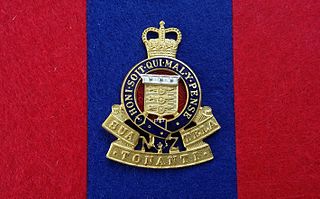 |
| New Zealand Army New Zealand Defence Force |
|---|
| Components |
| Administration |
| Regiments |
| Corps |
| Equipment |
| New Zealand portal |
A corps in the New Zealand Army is an administrative group that comprises members of similar work functions.
 |
| New Zealand Army New Zealand Defence Force |
|---|
| Components |
| Administration |
| Regiments |
| Corps |
| Equipment |
| New Zealand portal |
A corps in the New Zealand Army is an administrative group that comprises members of similar work functions.
The following is a list of the Corps of the New Zealand Army, ordered according to the traditional seniority of all the Corps. [1]
The New Zealand Medical Corps gained a Royal Warrant in 1947 and therefore became the Royal New Zealand Army Medical Corps.
Corps is a term used for several different kinds of organization. A military innovation by Napoleon I, the formation was first named as such in 1805. The size of a corps varies greatly, but two to five divisions and anywhere from 40,000 to 80,000 are the numbers stated by the US Department of Defense.
Colonel-in-chief is a ceremonial position in a military regiment. It is in common use in several Commonwealth armies, where it is held by the regiment's patron, usually a member of the royal family.

The Royal New Zealand Army Logistic Regiment, is the New Zealand Army's main military Logistics and combat service support (CSS) element. It is the largest regiment in the NZ Army.
When a World War I medal was issued to a member of Commonwealth forces, it was issued with a Service Number, Rank, Name and Regiment. This information should be on every medal that was issued during the First World War.

The Royal New Zealand Electrical and Mechanical Engineers (RNZEME) was a New Zealand Army Corps comprising Army trained tradesmen (craftsmen) who repaired Army equipment wherever New Zealand Forces served.
The 1944 New Year Honours were appointments by many of the Commonwealth realms of King George VI to various orders and honours to reward and highlight good works by citizens of those countries. They were announced on 31 December 1943.
The 1946 King's Birthday Honours, celebrating the official birthday of King George VI, were announced on 13 June 1946 for the United Kingdom and British Empire.
The 1940 Birthday Honours were appointments by King George VI to various orders and honours to reward and highlight good works by citizens of the British Empire. The appointments were made to celebrate the official birthday of The King, and were published on 9 July 1940.
The 1917 Birthday Honours were appointments by King George V to various orders and honours to reward and highlight good works by citizens of the British Empire. The appointments were made to celebrate the official birthday of The King, and were published on 4 June and 19 June.
The 1919 Birthday Honours were appointments by King George V to various orders and honours to reward and highlight good works by citizens of the British Empire. The appointments were made to celebrate the official birthday of The King, and were published in The London Gazette from 3 June to 12 August. The vast majority of the awards were related to the recently ended War, and were divided by military campaigns. A supplementary list of honours, retroactive to the King's birthday, was released in December 1919.
The 1917 New Year Honours were appointments by King George V to various orders and honours to reward and highlight good works by citizens of the British Empire. The appointments were published in several editions of The London Gazette in January and February.

The Royal New Zealand Army Ordnance Corps (RNZAOC) concerned itself with the provisioning of troops with the means to fight; specifically uniforms, weapons and equipment. Ordnance functions go back hundreds of years; the first Ordnance Officer in the British military appeared in the year 1299. Designated "Keeper of the King's Wardrobe", his duties included the care and accounting of heavy equipment such as battering rams and catapults.

New Zealand Force South East Asia (NZFORSEA) (1974–1989) comprised the elements of the Royal New Zealand Navy, New Zealand Army and Royal New Zealand Air Force. Much of the New Zealand military left Singapore as part of operation Kupe in 1989, leaving behind a residual Defence Support Unit (NZDSU).
The 1961 New Year Honours in New Zealand were appointments by Elizabeth II on the advice of the New Zealand government to various orders and honours to reward and highlight good works by New Zealanders. The awards celebrated the passing of 1960 and the beginning of 1961, and were announced on 31 December 1960.
This is a list of Meritorious Service Medals (MSM) awarded in the 1919 New Years Honours.
This is a list of Meritorious Service Medals (MSM) awarded in the 1918 Birthday Honours.
This is a list of Member of the Order of the British Empire (MBE) awards in the 1919 Birthday Honours.
The 1962 New Year Honours in New Zealand were appointments by Elizabeth II on the advice of the New Zealand government to various orders and honours, rewarding and highlighting good works by New Zealanders. The awards celebrated the passing of 1961 and the beginning of 1962, and were announced on 1 January 1962.
The 1919 King's Birthday Honours in New Zealand, celebrating the official birthday of King George V, were appointments made by the King on the recommendation of the New Zealand government to various orders and honours to reward and highlight good works by New Zealanders. They were announced on or dated 3 June 1919.